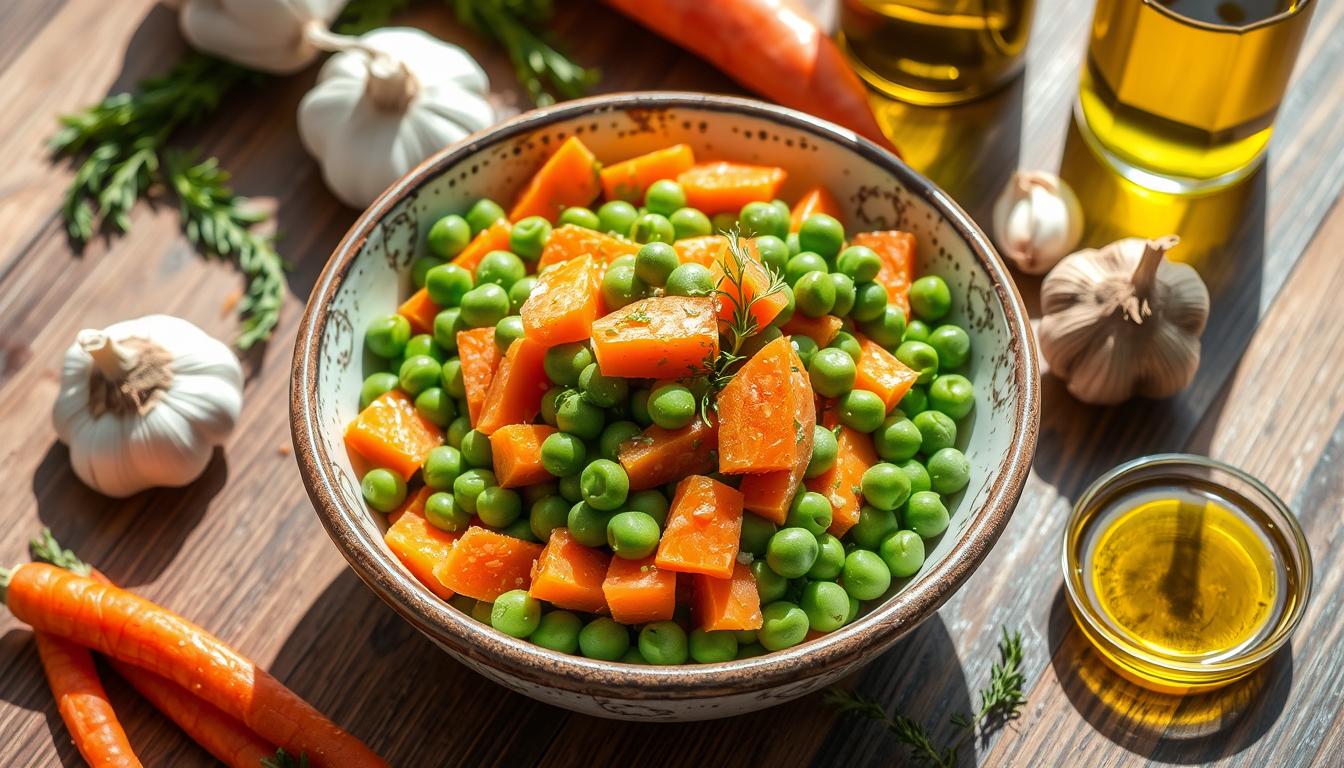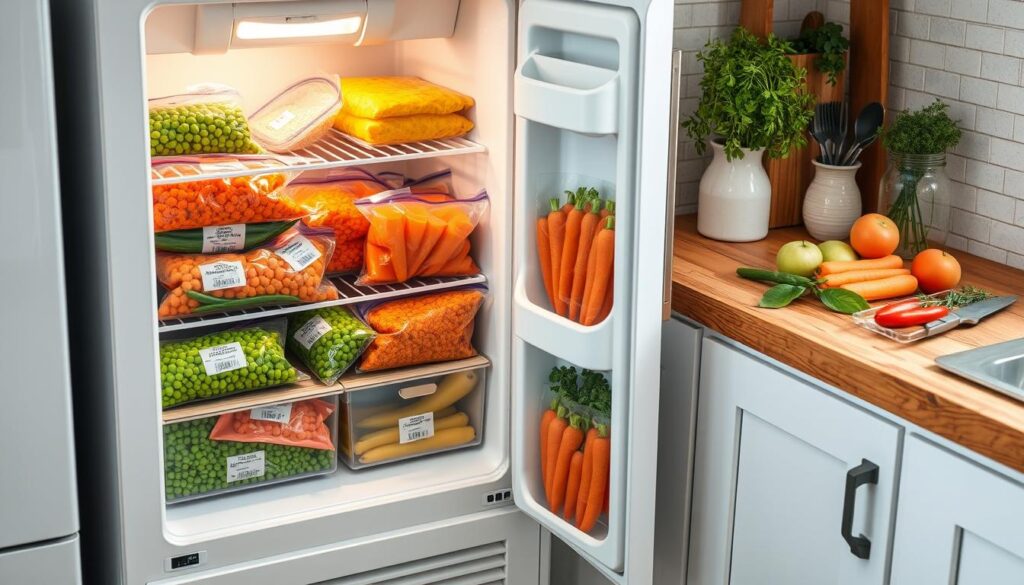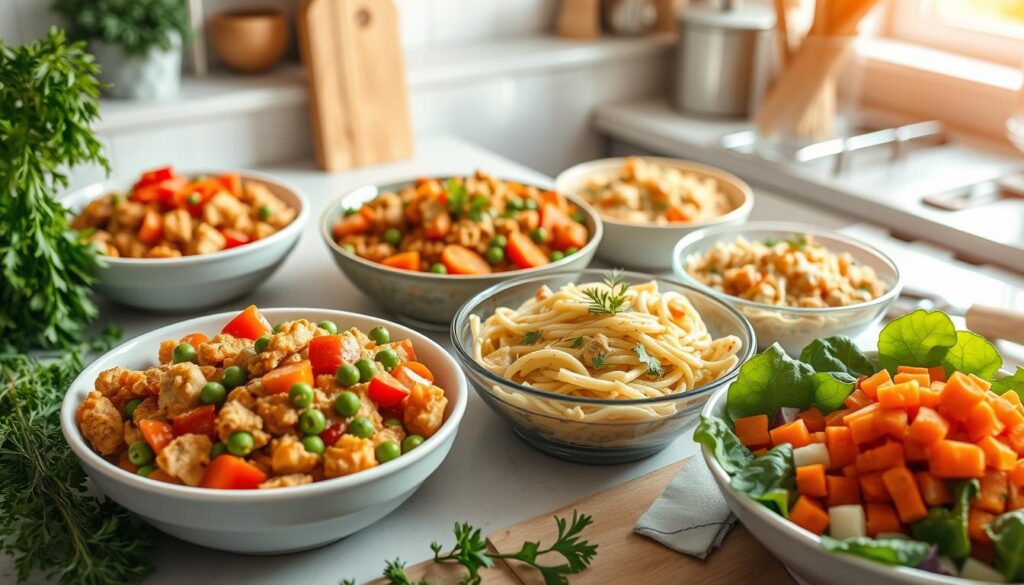Ever stared into your freezer, wondering how to turn frozen veggies into a tasty side dish? Frozen peas and carrots are your secret to easy, healthy sides.
Busy cooks face the challenge of making quick meals without losing flavor. These recipes are your answer to a tasty dinner in minutes. Imagine making a simple bag of frozen veggies into a side dish that everyone will love.
These veggies are full of nutrients and easy to use. They can make any meal special with little effort. Whether you’re an expert in the kitchen or just starting, these ideas will change your cooking.
Key Takeaways
- Frozen peas and carrots are incredibly convenient and nutritious
- Recipes take less than 15 minutes to prepare
- Perfect for busy weeknight meals
- Offers versatile cooking options
- Provides essential vitamins and minerals
Why These Vegetable Combinations Make Perfect Quick Meals
Frozen peas and carrots have changed how we cook fast meals. They make it easy to eat healthy without spending hours cooking.
Benefits of Using Frozen Vegetables
- Nutrition locked in at peak freshness
- Minimal preparation time (just 15 minutes)
- Impressive nutrient profile per serving
The nutritional benefits are amazing. Just one serving gives you:
- 9,801 IU of Vitamin A (196% daily value)
- 13 mg of Vitamin C (16% daily value)
- 4g of plant protein (8% daily value)
Time-Saving Advantages
Imagine making meals faster with veggies already washed and chopped. Frozen peas and carrots save you time, so you can enjoy your meal more.
“Cooking should be quick, nutritious, and enjoyable – and frozen vegetables make that possible.” – Culinary Expert
Nutritional Value Retention
Frozen veggies keep most of their nutrients. They’re frozen quickly at peak ripeness, keeping vitamins and minerals for your health.
In just 15 minutes, you can make a tasty, healthy side dish. Frozen veggies make healthy eating easy.
Essential Ingredients for Perfect Peas and Carrots
Making tasty peas and carrots is all about the right ingredients. You need the perfect mix to turn frozen veggies into a dish you’ll remember.
- 1 (16-ounce) package of frozen baby peas
- 1 (16-ounce) package of baby carrots
- 3 tablespoons unsalted butter
- Kosher salt
- Freshly ground black pepper
Want to make your dish even better? Add these optional ingredients for extra flavor:
- Fresh chopped parsley
- Dried thyme leaves
- Chili powder
- Cumin
- Fresh basil leaves
“Simple ingredients can create extraordinary flavors when prepared with care and creativity.”
Need to make it vegan or low-fat? Use plant-based butter or olive oil instead of regular butter. This way, everyone can enjoy your dish.
| Ingredient | Nutritional Value | Serving Size |
|---|---|---|
| Frozen Peas | High in Vitamin A | 1/2 cup |
| Baby Carrots | Rich in Vitamin C | 1/2 cup |
| Butter | Adds richness | 1 tbsp |
The charm of this dish is its simplicity. With just a few pantry staples, you can whip up a side that goes great with roasted chicken, meatloaf, grilled steak, or seafood.
Basic Butter and Garlic Sautéed Frozen Peas and Carrots
Turn your frozen veggies into a tasty side dish with simple sautéing. Peas and carrots add flavor to any meal with little effort.
Preparation Tips for Perfect Sautéing
Start by getting your ingredients and tools ready. Good sautéing of frozen veggies needs a well-prepared kitchen. You’ll need:
- Large skillet or sauté pan
- Sharp chef’s knife
- Wooden spoon or spatula
- Measuring spoons
Cooking Instructions for Garlic Butter Sauce
Make a delicious garlic butter sauce to make frozen veggies a gourmet side. Here’s how:
- Melt 3 tablespoons of unsalted butter in a skillet over medium heat
- Add finely minced garlic and sauté for 30 seconds
- Put frozen peas and carrots straight from the freezer
- Cook for 5-7 minutes, stirring now and then
Seasoning Suggestions for Frozen Vegetables
Boost your frozen veggies with these seasonings:
| Seasoning | Quantity | Flavor Profile |
|---|---|---|
| Sea Salt | 1/4 teaspoon | Basic enhancement |
| Black Pepper | 1/8 teaspoon | Mild heat |
| Dried Parsley | 1 teaspoon | Fresh herb notes |
| Lemon Zest | 1/2 teaspoon | Bright citrus touch |
Pro tip: Try different herbs to find your favorite flavor!
“Cooking is about passion, so it may look slightly temperamental in a way that it’s too assertive to the naked eye.” – Gordon Ramsay
Best Cooking Methods for Optimal Texture
Learning how to cook frozen vegetables right is crucial. It helps keep their taste and texture great. The way you cook frozen peas and carrots can really impact your dish’s quality.
“Flash-frozen vegetables capture nutrients at their peak, giving you a fresh taste with minimal preparation.” – Culinary Expert
Steaming and sautéing are the top methods for keeping veggies fresh. Each method has its own benefits for enhancing your frozen veggies.
Steaming: The Gentle Approach
- Preserves nutrients and color
- Prevents mushiness
- Recommended cooking time: 4-6 minutes
Sautéing: Flavor Development Technique
Sautéing is quick and adds flavor. Use medium-high heat and don’t overcrowd the pan.
| Cooking Method | Time | Texture Result |
|---|---|---|
| Steaming | 4-6 minutes | Tender, vibrant |
| Sautéing | 6-8 minutes | Slightly caramelized, flavorful |
Steaming vs sautéing tip: Cook carrots first, then add peas. This way, both veggies are tender at the same time.
Seasoning Secrets
Enhance your frozen vegetables with simple additions:
- Butter or olive oil
- Fresh herbs
- Garlic
- Lemon zest
The aim is to keep the natural sweetness and texture of your frozen peas and carrots. You want to make a tasty, healthy side dish.
Elevated Flavoring Options and Variations
Turning frozen peas and carrots into gourmet dishes is simple. Just add some herbs and spices. This turns a basic side into a dish that’s a hit globally.
Herbs and Spices Combinations
Discover new flavors for your veggies:
- Mediterranean blend: Fresh basil, oregano, and lemon zest
- Indian-inspired: Garam masala and cilantro
- Asian fusion: Sesame oil, green onions, and soy sauce
- Provençal style: Thyme, rosemary, and garlic
Gourmet Add-ins for Texture and Flavor
Make your dish better with these:
- Toasted sliced almonds
- Crispy pancetta bits
- Crumbled goat cheese
- Caramelized shallots
International Flavor Profiles
Try these global flavors:
| Cuisine | Flavor Additions |
|---|---|
| Thai | Coconut milk, red curry paste |
| Mexican | Chipotle powder, lime juice |
| Middle Eastern | Za’atar spice blend, sumac |
These herbs and spices will make your veggies a hit. Try different mixes and find your favorite!
“Cooking is about passion, so it may look slightly temperamental in a way that it’s too assertive to the naked eye.” – Gordon Ramsay
Tips for Selecting and Storing Frozen Vegetables
Choosing quality frozen produce can change how you cook and eat. When picking frozen peas and carrots, look for the freshest and best quality.
When choosing frozen vegetables, consider these key points:
- Absence of visible ice crystals
- Tight, intact packaging
- Vibrant color and consistent texture
- Reputable brand known for quick freezing
Storing frozen vegetables right is key to keeping them fresh. Store them in the coldest part of your freezer. This keeps their nutrients and taste better.
“Freezing vegetables at their peak ensures maximum nutrient retention and flavor preservation.”
After opening a package, move unused parts to airtight containers or freezer bags. Remove air to stop moisture buildup and keep quality high.
Here are some tips for storing frozen vegetables:
- Label packages with freezing date
- Use zip-lock bags for efficient storage
- Keep vegetables at 0°F or lower
- Consume within 8-12 months for optimal quality
By following these tips, you’ll get the most out of your frozen vegetables. This way, you’ll always have tasty and healthy meals ready.
Common Cooking Mistakes to Avoid
Cooking frozen peas and carrots might seem simple, but there are crucial cooking tips to ensure perfect results every time. Many home cooks struggle with maintaining the right texture and flavor when preparing these versatile vegetables.
Understanding the potential pitfalls can transform your vegetable preparation from mediocre to magnificent. Avoiding overcooked vegetables requires precision and attention to detail.
Temperature Control Challenges
Expert nutritionist Dana Angelo White highlights that high heat can degrade essential nutrients. When cooking frozen vegetables, maintain a medium-high temperature to preserve nutritional value while achieving optimal texture.
- Keep heat consistent during cooking
- Avoid extreme temperatures that can destroy nutrients
- Use quick cooking methods like roasting or light sautéing
Timing Considerations
Toby Amidor, MS, RD, emphasizes that different vegetables require varying cooking times. Carrots typically need more cooking time compared to peas, so add them first to ensure even cooking.
- Start with carrots
- Add peas after 1-2 minutes
- Cook until vegetables are tender but not mushy
Proper Seasoning Techniques
Mastering proper seasoning techniques can elevate your frozen vegetable dishes. Salt can draw out moisture, so add it towards the end of cooking to maintain the vegetables’ natural texture and flavor.
“The key to perfect vegetables is understanding their unique cooking requirements and respecting their natural qualities.” – Culinary Expert
By implementing these cooking tips, you’ll create delicious, nutrient-rich vegetable dishes that impress even the most discerning palates.
Pairing Suggestions and Meal Ideas
Frozen peas and carrots are great for meal planning. They add variety to your dinners. Pairing them with proteins can make your meals both healthy and tasty.
- Grilled chicken breast with herb-seasoned peas and carrots
- Roasted pork tenderloin accompanied by garlic-sautéed vegetables
- Pan-seared salmon with lemon-infused vegetable medley
- Quinoa and black bean bowl topped with seasoned peas and carrots
There are many ways to use peas and carrots in your meals. Stir-fries are perfect for mixing proteins with them. Pasta dishes also benefit from their color and nutrition. For a vegetarian option, try making grain bowls or vegetable pot pies.
Pro tip: A cup of peas and carrots contains only 167 calories while providing essential nutrients – making them an ideal choice for health-conscious meal planning.
Research shows that eating a variety of foods, including peas and carrots, can lower disease risks. By adding these to your meals, you’re making dishes that are good for your health.
Make-Ahead and Storage Guidelines
Learning how to prep frozen peas and carrots can change your kitchen game. Storing leftovers right keeps your veggies fresh and full of flavor. It also helps cut down on waste.
Here’s what to do when storing peas and carrots:
- Cool cooked veggies completely before storing
- Use airtight containers to stop moisture and freezer burn
- Mark containers with the prep date
For 2-3 days, cooked peas and carrots stay fresh in the fridge. Freezing is great for longer storage, keeping them tasty.
“Proper storage is the key to keeping your meal prep ingredients fresh and delicious.” – Professional Chef
Freezing tips for your veggies:
- Peas can be frozen for up to 8 months
- Carrots stay good for 1 year in the freezer
- Cooked dishes can be stored 4-6 months
When reheating, use gentle methods to keep texture. A quick sauté or microwave on medium is best. If you used butter, it might solidify when cooled.
Pro tip: Portion your meals before freezing to make reheating more convenient and reduce waste.
By following these storage tips, you’ll make meal prep with frozen peas and carrots easy and healthy.
Time-Saving Kitchen Tips for Working with Frozen Peas and Carrots
Learning to cook frozen peas and carrots quickly can change how you make meals. These veggies are great for making cooking easier and healthier.
Here are some smart ways to cook frozen veggies fast:
- Store frozen veggies in clear, stackable containers for easy access
- Use large skillets to increase cooking surface and reduce preparation time
- Keep a variety of frozen veggies ready for quick meal additions
Pro tip: Frozen veggies are pre-washed and pre-chopped, cutting your meal prep time dramatically.
“Frozen vegetables are your secret weapon for quick, nutritious meals” – Professional Chef
Here are some quick cooking tips:
- Add frozen veggies directly to hot dishes without thawing
- Use microwave-safe containers for rapid reheating
- Batch cook and portion meals for future quick dinners
Using these tips will make cooking faster and meals healthier with less effort.
Conclusion
Frozen peas and carrots are a great side dish. They make quick and easy recipes healthier. They have almost as many nutrients as fresh veggies.
Studies show they keep up to 90% of their nutrients. This makes them perfect for those who are always on the go. They want to eat well but don’t have much time.
Having frozen peas and carrots in your kitchen is smart. They are a backup for meals, which 86% of people use. They are affordable and last a long time, helping you avoid food waste.
They are also good for your pantry. You can always have healthy veggies ready to go. This makes meal planning easier and saves you money.
Cooking with frozen peas and carrots is fun. You can steam, sauté, or add them to many dishes. They stay nutritious and tasty.
Learning how to cook them well is key. You can make them into something special. This way, you can enjoy delicious and healthy meals without much effort.
Choosing the right ingredients is important for good cooking. Frozen peas and carrots are more than just a side. They open the door to easy, tasty, and healthy meals that fit today’s busy lives.
FAQ
How long do frozen peas and carrots last in the freezer?
Can I cook frozen peas and carrots without thawing them first?
What are the best ways to season frozen peas and carrots?
How long does it take to cook frozen peas and carrots?
Are frozen peas and carrots nutritionally valuable?
Can I make a vegan version of peas and carrots?
How should I store leftover cooked peas and carrots?
What main dishes pair well with peas and carrots?
Source Links
- Peas and Carrots – https://vegetablerecipes.com/peas-and-carrots/
- Buttery Frozen Peas and Carrots Recipe in 15 minutes! – https://mygoodfoodworld.com/frozen-peas-and-carrots-recipe/
- Peas and Carrots: How to Give This Classic Combo an Upgrade – https://www.culinaryhill.com/peas-and-carrots/
- Delicious Frozen Peas and Carrots Recipes for Quick Meals – https://savoryrecipes.net/delicious-frozen-peas-and-carrots-recipes/
- Peas and Carrots – https://www.foodfaithfitness.com/peas-and-carrots/
- Peas and Carrots (One Pan) – https://theclevermeal.com/peas-and-carrots/
- Peas and Carrots Is a Simple and Delicious Side Dish – https://www.thespruceeats.com/peas-and-carrots-482764
- Carrots and Peas – https://www.deliciousmeetshealthy.com/carrots-and-peas/
- How I cook frozen peas – Garlic Buttered Peas – https://www.recipetineats.com/how-i-cook-frozen-peas-recipe/
- Buttery Peas {How To Cook Frozen Peas the BEST Way!} – Key To My Lime – https://keytomylime.com/buttery-peas-recipe-how-to-cook-frozen-peas/
- How to Make Frozen Vegetables Taste Just as Good as Fresh – https://www.eatingwell.com/article/7805712/how-to-make-frozen-vegetables-taste-just-as-good-as-fresh/
- How to Cook Frozen Peas – https://www.favfamilyrecipes.com/how-to-cook-frozen-peas/
- The BEST Way To Cook Frozen Peas (+Our Favorite Seasoning!) – https://www.onelovelylife.com/how-to-cook-frozen-peas/
- How to Cook Frozen Peas + Carrots – https://longbournfarm.com/frozen-peas-and-carrots/
- Quick and Easy Peas and Carrots – https://pinchmegood.com/peas-and-carrots/
- Frozen Peas and Carrots: Quick & Easy Side Dish – https://www.overrecipes.com/frozen-peas-and-carrots/
- how to freeze vegetables at home | frozen peas, green beans carrots & mixed vegetables – https://hebbarskitchen.com/how-to-freeze-vegetables-frozen-peas/
- Why I’ll Never Open Another Bag of Frozen Vegetables Without the “U-Rule” Again – https://www.thekitchn.com/open-bag-of-frozen-vegetables-tip-23661645
- 4 Cooking Mistakes You’re Probably Making With Frozen Vegetables – https://www.allrecipes.com/cooking-frozen-vegetables-mistakes-7370118
- 5 Mistakes to Avoid When Cooking Frozen Vegetables – https://www.thekitchn.com/frozen-vegetable-mistakes-259663
- Peas and Carrots Recipe – https://www.mariaushakova.com/2020/10/peas-and-carrots-recipe/
- 26 Recipes that Start with a Bag of Frozen Peas – https://www.tasteofhome.com/collection/frozen-peas-recipes/?srsltid=AfmBOornx5jaV909oY6LymjDQYVOCmvvXs7jzi9SxV7NgwqJ0tApmB3e
- History’s Greatest Pairings: Peas and Carrots – https://www.chefs-garden.com/blog/july-2019/history’s-greatest-pairings-peas-and-carrots
- This Is How Long Food Can Be Frozen and Stored in Your Freezer – https://www.thespruceeats.com/storing-food-in-the-freezer-1327662
- How to Store Any Vegetable to Keep It Fresh as Long as Possible – https://www.foodandwine.com/vegetables/how-to-store-any-vegetable
- How to Use Frozen Vegetables | Cook Smarts – https://www.cooksmarts.com/articles/use-frozen-veggies/
- 7 Smart Tips to Help You Cook Frozen Veggies Like a Pro – https://www.thekitchn.com/frozen-vegetable-cooking-tips-259727
- Are Frozen Vegetables Healthy? Nutrition and More – https://zoe.com/learn/are-frozen-vegetables-healthy
- Fresh versus Frozen Vegetables – https://www.lsuagcenter.com/articles/page1509638286014
- The Fresh or Frozen Produce Debate: Which One? – Mackenthuns – https://mackenthuns.com/fresh-frozen-produce-which-is-better-for-health-and-nutrition/



